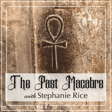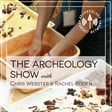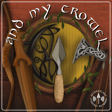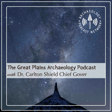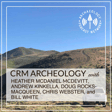Become a Creator today!Start creating today - Share your story with the world!
Start for free
00:00:00
00:00:01

Tombs from the Dawn of Egypt pt 1 - Ep 01
Travel back over 5,000 years to Nekhen and Abydos, and explore the predynastic and early dynastic tombs that laid the foundations for the iconic pyramids and grand tombs of Ancient Egypt. Discover how these early burial sites shaped royal displays of power, afterlife beliefs, and Egyptian art for millennia.
Links
- See photos related to episode topics on Instagram
- Loving the macabre lore? Treat your host to a coffee!
- Head over to the show notes page to see photos
ArchPodNet
- APN Website: https://www.archpodnet.com
- APN on Facebook: https://www.facebook.com/archpodnet
- APN on Twitter: https://www.twitter.com/archpodnet
- APN on Instagram: https://www.instagram.com/archpodnet
- Tee Public Store: https://www.teepublic.com/stores/archaeology-podcast-network?ref_id=5724
Affiliates
Transcript
Introduction to Past Macabre Podcast
00:00:01
Speaker
You're listening to the Archaeology Podcast Network.
Exploring Egyptian Tombs
00:00:27
Speaker
Welcome to the past macabre, where we journey through history to uncover how our relationship with death reflects the values, fears, and hopes that shape the way people live.
00:00:40
Speaker
Together, we'll explore topics such as the burial practices of ancient cultures across the world, locations and artifacts associated with the afterlife, the beings who guard the gates between life and death, and so much more. I'm your
Evolution of Pyramids
00:00:57
Speaker
host, Stephanie Rice, and I want to thank you for joining me for episode one, Tombs from the Dawn of Egypt.
00:01:04
Speaker
The pyramids of Giza are among humanity's most awe-inspiring achievements, and they are some of the most iconic examples of ancient burial monuments. But the ancient Egyptians didn't suddenly start building pyramids one day out of the blue. These monuments are the culmination of centuries of evolving architectural styles, traditions, and practices surrounding death and the afterlife.
Neckin and Early Kingship
00:01:32
Speaker
In this episode, we'll journey to the ancient cities of Neckin and Abidos for insights into both life and death during the dawn of ancient Egypt. We'll explore tombs of the predynastic and early dynastic elite that paved the way for the grandeur of the pyramids and elaborate funerary complexes that became part of ancient Egypt's cultural identity.
00:02:03
Speaker
Long
Trade Influence on Burial Rituals
00:02:04
Speaker
before the pyramids, even before dynasties or the tidal pharaoh came to be, Neckin was a large, bustling city. It prospered thanks to its many crafters who produced goods that were traded far along the Nile Valley. By about 3600 BCE, this successful trade combined with successful military campaigns allowed the leaders of Neckin to expand their influence further and further along the Nile.
00:02:32
Speaker
Because of their expansion, many of the burial rituals and symbols of kingship that were used in later periods can trace their origins here to the ancient cemeteries of Neckin. For example,
Hierakonpolis and Horus Worship
00:02:43
Speaker
all across Egypt, there are pyramid texts, tomb art, and statues of royals that invoke the protection and guidance from the souls of Neckin. They represented the spirits of the early kings who were buried here and who could guide and protect the current pharaohs.
00:03:01
Speaker
Later, Neckin became known as Hierakonpolis, which is Greek for city of the Falcon. This is because it's the site of the oldest and largest temple dedicated to the god Horus.
00:03:12
Speaker
This is likely where his worship originated, over 7,000 years ago.
Royal Symbols and Tomb Styles
00:03:18
Speaker
And throughout Egypt's extensive history, the roles, powers, and the importance of all of the deities changed or merged many, many times. But throughout his many forms as a god of war, healing, the sky, and so much more, Horus was associated with kingship more often than not.
00:03:36
Speaker
For over 3,000 years, in every period from the early dynastic to the Ptolemaic, a Horus name was given to most pharaohs as one of their royal titles when they ascended to their throne. Rulers used these traditions to link themselves to the powerful leaders of the past, the followers of Horus from Neckin. This symbolically legitimized their place amongst these legendary figures.
Tomb 23: Egypt's Earliest Complex
00:04:02
Speaker
Much like the royal symbols and titles, we can trace the origins of tomb styles and funerary practices here. This was another way the long lines of royals connected themselves to this venerated place of Horus. Now, let's start looking at the beginnings of these traditions here at the southwestern edge of where the archaeological site is today.
00:04:23
Speaker
There is a shallow valley or what's called a Wadi in Arabic that's nestled into the desert sands. Just at the entrance rests HK6 as it's been designated by archaeologists.
00:04:36
Speaker
This is the oldest necropolis discovered at Neckin. Here lie the tombs of Neckin's elite. The royals, religious leaders, administrators, and master crafters whose names may be lost, but their influence here at the dawn of Egypt echoes through time. Within Necropolis HK 6 is Tomb 23. Today, it appears as little more than a series of unassuming pits in the sand,
00:05:03
Speaker
like you would see at the beach, but this is the earliest funerary complex ever found in Egypt. This dates to about 3600 BCE, which is about a thousand years before the first pyramid in Egypt was even conceived. This tomb was a large burial pit that was dug into the sand and sediment floor of the wadi.
00:05:24
Speaker
This burial pit style was very common in this period. However, this is the largest of any lycra that have been found from this time period. And unlike any of the other pit burials from this time, Tomb 23 once rested beneath a rectangular wooden building that was supported by eight columns that surrounded the tomb.
00:05:45
Speaker
This may be one of the first examples of an above ground structure for a tomb, an early step towards the grand surface monuments that would become the most well recognized part of Egypt for ages to come.
Animal Burials and Rituals
00:05:57
Speaker
The remains of 12 different people have been found inside the main tomb, but unfortunately, centuries of looting have done so much damage that researchers can't tell who was a part of the original burial and who was interred later.
00:06:12
Speaker
Next to the tomb stood a smaller wooden structure that was likely an offering temple based on the artifacts that were found there. Outside of the offering temple, there once stood the first life-sized human statue in Egypt. It was carved out of limestone that had to have been imported to the tomb from afar. Researchers can tell because there's no limestone in the area that they could have quarried this from.
00:06:38
Speaker
Unfortunately, time, the elements, and human interference have left the statue now shattered into over 600 small fragments. However, there are well-preserved nose and ear fragments to confirm the size of the statue. Conservatives have worked really hard to piece together enough of these fragments to identify that the figure was probably sitting on a throne. This type of pose was common in the later statues constructed all across Egypt throughout the dynastic periods.
00:07:09
Speaker
Surrounding the main tomb, the Offering Temple and the statue, there was a wooden wall that was covered with a red plaster, which confirms that they were intended to be a part of the same complex. Directly south of Tomb 23, there was a large above-ground structure, designated as structure E8. A wall similar to that of Tomb 23 surrounded it, but archaeologists have yet to determine when it was built in relation to Tomb 23.
00:07:37
Speaker
The remaining pigment suggests that it was green plaster on this wall instead of a red, so the colors don't match up. But a four meter wide walled corridor connects this wall to Tomb 23's wall. That doesn't necessarily mean that they were constructed at the same time or that they were originally intended to be connected, but it is interesting.
00:08:01
Speaker
Structure E8 was impressive on its own, regardless of its relation to tomb 23. It was one of the earliest iterations of a hypostyle hall in Egypt. Later in Egypt's history, these would become a defining architectural feature of ancient Egyptian temples especially. The most famous example is the great hypostyle hall at Karnak. Here at Structure E8, there were 24 massive acacia wood columns.
00:08:32
Speaker
and they were evenly spaced just like later hypostyle hulls. Sometime after structure E8 was built, one of its columns was removed in order to place a very unique burial underneath it. The bones of an African elephant and an aurac, a now extinct species of wild cow, were found on top of a neatly emptied post hole and then wrapped in burial shrouds.
00:08:59
Speaker
This is proof that this burial location was intentional. Were they possibly sacred animals? This was something that was done at later temples.
Influence on Future Pharaohs
00:09:10
Speaker
Were they possibly exotic status symbols that were kept in a menagerie by one of the elites buried nearby? This was also seen in later periods when elite would capture or import animals from all over Africa, the Levant, and the Mediterranean just to show that they could. Some researchers have even suggested that here at Neckin, this is the example of the very first zoo in the world.
00:09:41
Speaker
In addition to these burials here at structure E8, there are several other exotic and difficult to own and capture animal burials throughout the cemetery that date from different years, but they are all within the same space.
00:09:59
Speaker
Unfortunately, there is no solidified evidence to give us the exact answer. But curiously, the structure here at E8 with the elephant and the auroch burial show that the structure was still in use well after the column was removed.
00:10:18
Speaker
The structure was heavily looted by the time archaeologists began their research here, so it's hard to tell definitively, but many of the artifacts that remain hint that this structure was used for ceremonial purposes for quite a while. Another find of note here at E8 is a fishtail-shaped ritual knife. This design is known to be the precursor to the special knife that was used to cut umbilical cords of newborns in ancient Egypt.
00:10:46
Speaker
This tool was also used in a ritual called the opening of the mouth ritual. This was done at death and symbolized rebirth and originally in the Old Kingdom it was used to grant statues the ability to hold the spirit or the Ka of the deceased. This way they could eat and drink the offerings that were left for the deceased in order to sustain them in the afterlife.
00:11:11
Speaker
Over time, it became incorporated as part of the mummification rituals for the same symbolic rebirth of the deceased. This time instead of a statue, it was the mummy of the deceased that was reborn into the afterlife. Perhaps structure E8 is a very early precursor to the mummification workshops where the opening of the mouth ritual was performed in later periods. Unfortunately, looters have made it impossible to confirm either way.
00:11:41
Speaker
As the rituals evolved, so too did the funerary complexes themselves. Following the precedent set with Tomb 23, later funerary complexes typically included multiple structures. One of them was usually an offering temple, and
The Painted Tomb's Significance
00:11:57
Speaker
they had one or more statues, and often there were additional relatives of the deceased interred either in the same tomb or in their own smaller tombs.
00:12:06
Speaker
It's unclear if the 12 people that were buried in the main chamber of tomb 23 were related, because like I said, there was so much damage done to the remains. But it is possible that this was a precursor to these practices. These funerary complexes were common for pharaohs throughout ancient Egypt, and they became major projects during the king's lifetime.
00:12:32
Speaker
This pattern set here at Tomb 23 became ingrained in cultural memory as the blueprint for eternal elite status symbols for over 2,500 years. In the century following the construction of Tomb 23 at Neckin, something happened to cause the elites to abandon Cemetery HK 6 and start a new one to the north.
00:12:56
Speaker
Several structures at HK 6, including Tomb 23, have large amounts of charred matting and fence remains that indicate that they were burned. It's hard to pinpoint when exactly this occurred. The limestone life-size statue at Tomb 23 has strong evidence that it was intentionally shattered instead of being destroyed by natural erosion. But again, it's impossible to determine when this happened.
00:13:24
Speaker
Were the fire and the smashing of the statue caused by a violent shift in power from one ruler to the next? Was the movement of the cemeteries and the fire and the destruction caused by a violent shift in power from one ruler to the next? Was this an example of an early act of damnatio memore? This means damning of the memory in Latin, and it was done throughout antiquity in many different places.
00:13:54
Speaker
The earliest definitive evidence of its use in Egypt is during the New Kingdom, and then it was used well into the Roman period as well. For a culture so drawn to preserving immortality through inscriptions, paintings, and statuary, this must have been seen as one of the worst curses imaginable.
00:14:15
Speaker
Next, we'll take a look at that new necropolis to the north. It's been designated HK31 by archaeologists, and the most famous of the tombs found in it is Tomb 100. This tomb is also known as the Painted Tomb, and it is the earliest example of tomb art painted on the walls of any Egyptian tomb.
00:14:37
Speaker
It was still a subterranean burial, but the pit walls were lined with mud bricks that were covered with plaster. The plaster created a smooth, uniform surface that was used as a base to paint vibrant and elaborate scenes onto the tomb walls. This tradition carried on through the ages. It was still favored by the New Kingdom rulers that are buried in the Valley of the Kings and the Valley of the Queens over 2,000 years later. It also goes well into the Ptolemaic and the Roman periods.
00:15:08
Speaker
The subjects of the paintings in tombs 100 are another early example of what became a widespread practice. It depicts scenes of the deceased in military triumph or dominating the natural world through various hunts and expeditions. These became commonplace for elite tombs throughout Egypt's history. One of the paintings on the walls of the painted tomb shows the deceased in what has become known as the smiting pose.
00:15:36
Speaker
This is one of the most commonly used images by Egyptian rulers. Even though the details and art styles differ over time, the smiting pose always shows the deceased holding a weapon over their head while standing over their captive enemies. This symbolized militaristic power and triumph over these enemies. Another painting within the tomb shows what's become known as the Master of Animals motif.
00:16:06
Speaker
It shows the deceased holding two fighting lions at bay, one lion in each hand on either side. This is also a symbol of triumph over chaos in the natural world this time. Both the smiting pose and the master of animals motifs became deeply ingrained in cultural iconography on tombs because both represent the protection needed in life.
00:16:34
Speaker
The smiting scene is carved into larger-than-life reliefs on later temples, such as Karnak, onto the exterior to show all that the temple was protected by the pharaoh. This goes to show that it was such a widely recognized symbol of protection by the time that Karnak temple was built. As for the master of animals, most scenes using this motif depict the domination of the most dangerous animals, like hippos, crocodiles, lions, and aurochs.
00:17:03
Speaker
Otherwise, it'll show hunting scenes with large herds or flocks of animals. It shows these creatures that most people would certainly have a difficult time fighting in order to show that the Pharaoh is able to protect from them. They were important
Osiris Myth and Rituals
00:17:21
Speaker
parts of the Pharaoh's iconography to show that they were capable of protecting their subjects against all threats, man or beast.
00:17:31
Speaker
The painted tomb was also the earliest example of multiple chambers in a subterranean tomb. It has a wall dividing it in two, which might not seem like much, but at the time, it was groundbreaking. With tomb 23, the Offering Temple was an entirely above-ground structure made of wood, separate from the burial.
00:17:53
Speaker
likely aware of the damage that was done by looters and possibly the fire to their predecessor's tomb, um the person who commissioned tomb 100 chose to bury their offering temple with them. This is another tradition that will be carried on in the tombs of later rulers.
00:18:12
Speaker
Whoever was once interred in this tomb and the artist who painted it inspired an incredible legacy of art and architecture that's still being admired to this day, over 5,000 years later. If portions of Necropolis HK6 were intentionally destroyed by the founders of HK31, it would be ironic that HK6 is the one that remains today, while HK31 has been lost to the sands of time.
00:18:42
Speaker
As fate would have it, Cemetery HK 31 no longer exists because of the growth of modern communities and the need for more agricultural land. All of the tombs that were previously here have been completely destroyed. Even though the painted tomb is lost, its influential painting was luckily saved.
00:19:02
Speaker
The 1898 excavation team that came here carefully sketched and photographed the site and what remained of the art of the painted tomb. Some had already eroded due to time. The original plaster and then the paintings that were on top of it were moved from the tomb to the Egyptian Museum in Cairo for conservation.
00:19:25
Speaker
You can currently see these paintings from the painted tomb in the Egyptian Museum in Cairo. It will remain there until it's moved to the brand new Grand Egyptian Museum. While Nekin laid the foundation for the beliefs and symbols that would come to define Egyptian kingship, this was just the beginning of a much larger story.
Abydos, Osiris, and Festivals
00:19:47
Speaker
As we follow the Nile northward, about 200 kilometers or 124 miles roughly,
00:19:54
Speaker
will reach Avidos, another ancient city where rituals and architectural traditions that would shape Egypt's destiny for millennia were born. Here, in this sacred place, the worship of Osiris took root. Osiris, the god of fertility and rebirth, embodied not just the cycle of nature, but the very idea of death and resurrection.
00:20:19
Speaker
The death of each pharaoh and the rise of his successor mirrored the eternal balance of the Osiris myth, a divine cycle where life and death were two parts of a whole. And just as Osiris was reborn in the afterlife, so too was each new pharaoh, ensuring the eternal order of Egypt and the natural world.
00:20:43
Speaker
Though inscriptions found on pyramids date the Osiris myth to the Fifth Dynasty, it likely stretches much further back into the mists of oral tradition. According to this tale, Osiris's brother Set murdered him to claim the throne. Set, determined to prevent Osiris's resurrection, dismembered his body and scattered the pieces all across Egypt.
00:21:09
Speaker
Chaos reign under Set's rule until the other gods attempted to gather Osiris's remains, but their efforts to resurrect him failed. It was left to Horus, Osiris's son according to this myth, to avenge his father by defeating Set and reclaiming the throne. Osiris, now ruler of the afterlife, and Horus, now the living pharaoh, restored balance to Egypt and the natural world.
00:21:35
Speaker
Many believed that Osiris's head was entombed here at Abydos. This transformed the city into a sacred destination for pilgrims seeking favor in both life and death from this god of rebirth. The necropolis of Abydos, known today as Umm el Kaab, or the Mother of Pots, bears the evidence of this devotion.
00:22:00
Speaker
The desert sands here are littered with pottery fragments left behind by thousands and thousands of pilgrims, and by the ancient elite who sought to tie their fate to this sacred place with their own burials. By the Middle Kingdom, Abydos had become the center of a grand festival celebrating Osiris's death and rebirth. It was called Kaher Ka, hair co and this festival marked the beginning of the planting season and drew crowds from all over Egypt.
00:22:30
Speaker
While
Scorpion King's Tomb and Hieroglyphics
00:22:31
Speaker
the ancient Egyptian calendar shifted over time, many researchers believe this festival occurred in what we now know as November. Here, in the shadow of the tombs, dramatic reenactments of the Osiris myth played out before the gathered masses.
00:22:47
Speaker
Abydos is most likely the birthplace of theater, predating Greek tragedies by over a thousand years. Unfortunately, the evidence for Greek tragedies is much more solid, and the best that we have attributing to these dramatic reenactments are attestations that come from later periods. But Abydos is not just a city of the gods, it is also a city of kings.
00:23:14
Speaker
Among its tombs lie one of the most significant archaeological discoveries ever made in Egypt, the tomb of a ruler we know as the Scorpion King. This ruler, who lived around 3250 BCE, ruled in an era before Egypt was unified. His tomb is larger and more complex than any of its predecessors. Its 12 chambers were arranged in a precise grid pattern, and it was constructed of mud brick.
00:23:44
Speaker
Inside of the tomb lay the remains of a king whose real identity is still shrouded in mystery. We call him the Scorpion King because of the iconography that was found on the boat of Potts left for his burial offerings. Some believe that the Scorpion King may have been one of the last rulers of Upper Egypt just before it was united under Narmer. What makes this tomb even more fascinating is the jars found within it.
00:24:12
Speaker
Thousands of them, luckily overlooked by ancient looters, still contain traces of food and wine. Some of it was imported from as far away as Palestine. And on these jars, there are ivory labels used to mark goods that were buried with the king.
Narmer and Egypt's Unification
00:24:29
Speaker
These labels are edged with the earliest known examples of hieroglyphic writing. This pushes back the origins of Egyptian writing by nearly 200 years and places it even closer to the origins of writing in Mesopotamia.
00:24:43
Speaker
The sheer size of this tomb, along with the vast quantities of labeled provisions buried with the king, suggests the beginning of a tradition that would later define the pharaohs. Here, in the tomb of the Scorpion King, we see the first hints of the elaborate burials that were filled with provisions to sustain the king in the afterlife. Perhaps this is exactly where the idea of the pharaoh as a divine ruler Deserving of such grand displays, first began to take shape. Just 50 meters to the south of the tomb of the Scorpion King lies the resting place of an even more iconic figure, Narmer, the King who united Upper and Lower Egypt.
00:25:29
Speaker
Narmer's name echoes through history as the first ruler depicted wearing the double crown of Egypt, the white crown of Upper Egypt and the red crown of Lower Egypt combined. This symbolized the unification of the two lands. He's immortalized on the Narmer palette, which depicts him in the classic smiting pose, subduing his enemies and establishing his rule over a united Egypt.
00:25:55
Speaker
Narmer's tomb, however, is far more modest than that of the Scorpion King. It consists of only two subterranean chambers, their mud brick walls bare and undecorated. And yet it is here that one of Egypt's most important dynasties was born. Egyptologists identified the tomb as Narmer's based on inscriptions found on fragments of artifacts that were left behind after looters had come and gone.
00:26:20
Speaker
What's particularly fascinating is that after Narmer's burial, the tomb seems to have been repaired, even though this was also after the tomb had already been looted. A collapsed wall was rebuilt and then plaster was applied to the mud brick. This suggested that someone, perhaps even centuries after his death, deemed this tomb important enough to restore.
Hor Aha's Power Dynamics
00:26:46
Speaker
Could this have been an early cult dedicated to Narmer, ensuring that his memory was preserved long after his reign? It is possible because throughout Egypt's history, funerary cults cared for the tombs of rulers that came in later periods. They performed annual rituals that were designed to sustain and keep the spirits of the pharaohs alive in the afterlife.
00:27:13
Speaker
If Narmer's tomb was indeed maintained in this way for a long period, then Abidos' connection to the afterlife may have been strengthened even further by this. Perhaps this was the inspiration for the myth that Osiris himself was buried here. Next to Narmer's tomb lies the burial of his successor, Hor Aha. His name meant Horus the Fighter, or Fighting Horus, and it was likely a royal title rather than a birth name.
00:27:43
Speaker
and it is a fitting one. Inscriptions from his reign speak of a year of smiting during which he led bloody campaigns into Nubia. Even his death was marked with violence. With Hor Aha's tomb, we see a chilling display of power unlike anything that came before. In addition to his own burial chamber, 36 smaller graves surround the complex.
00:28:08
Speaker
These were not tombs for nobles or officials who died later and wanted to be buried near their king. They were retainer sacrifices. His closest servants, administrators, and most likely even family members were buried with him with evidence that they were sacrificed very close to the time of his death.
00:28:32
Speaker
This is a practice that thankfully did not last long into Egypt's history, but it's one that illustrates the immense power that this early king held, the ability to command life and death itself. The placement of Hor Aha's tomb is no coincidence. By choosing to be buried alongside Narmer with his larger tomb and his retainer sacrifices, Hor Aha was linking his reign to the man who had united Egypt.
00:29:00
Speaker
possibly his father, but it is unclear, yet showing a display of power that was larger than his predecessors. Interestingly, Hor Aha also had a cenotaph. This is a symbolic tomb where the deceased isn't buried here, but it represents them, similar to what we use for modern war memorials. This one was built for Hor Aha at Saqqara, far to the north,
00:29:30
Speaker
at the Necropolis for the Elites of the newly established capital of Egypt, Mennefer, or Memphis as we know it. This cenotaph was likely intended to connect Hor Aha to Egypt's future just as his tomb in Abydos connected him to the past. One of the most fascinating parts of Hor Aha's cenotaph is a model estate built within the walls of his funerary complex. This model estate complete with 20 granaries, was built with mud brick and filled in with rubble. This was a display of wealth and power designed to endure for eternity. Even for a
Podcast Credits
00:30:12
Speaker
model, it was large, covering an area of five meters by five meters or 16 feet by 16 feet roughly, which indicates the estate itself was quite likely very impressive.
00:30:25
Speaker
Like the painted scenes of hunting that would appear in later royal tombs, this model estate was a testament to Hor Aha's ability to provide food for his people. Abidos, then, is more than just a city of kings and gods. It is a place where the foundations of Egyptian kingship were laid, where the mortal
00:31:19
Speaker
This episode was produced by Chris Webster from his ah RV traveling the United States, Tristan Boyle in Scotland, DigTech LLC, Culturo Media, and the Archaeology Podcast Network, and was edited by Rachel Rodin. This has been a presentation of the Archaeology Podcast Network. Visit us on the web for show notes and other podcasts at www.archpodnet.com. Contact us at chrisatarchaeologypodcastnetwork.com.
